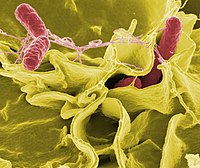
Photo from wikipedia
Abstract Salmonella enterica contaminates many food matrices, particularly poultry products. This study was initiated to characterize newly isolated lytic Salmonella phages and to evaluate their efficiency against S. enterica serovar… Click to show full abstract
Abstract Salmonella enterica contaminates many food matrices, particularly poultry products. This study was initiated to characterize newly isolated lytic Salmonella phages and to evaluate their efficiency against S. enterica serovar Enteritidis and Typhimurium in liquid whole eggs. Two phages (OSY-STA and OSY- SHC) isolated from livestock farms in Ohio, USA, exhibited lytic activities against 14 and 5 Salmonella serovars, respectively, including Salmonella Typhimurium and Salmonella Enteritidis. Based on their morphological characteristics, the lytic phages belong to Siphoviridae family. The OSY-STA and OSY-SHC phages had similar latent periods (∼20 min) and burst sizes of 176 and 256, respectively. The phages remained viable after exposure to acidic and alkaline environment (pH 5–11) and during holding at 4 °C to 55 °C. Liquid whole egg was inoculated with Salmonella serovars at ∼2.7 log CFU/ml, a level comparable to that encountered in naturally contaminated product, treated with the phages at 4 °C for 24 h, then mildly processed at 55 °C for up to 13 min. The combined process resulted in 1.8 and more than 2.5 log CFU/ml reduction in Salmonella Typhimurium and Salmonella Enteritidis, respectively. Therefore, Salmonella phages in combination with mild heat could be beneficial in controlling the pathogen in liquid whole eggs.
Journal Title: Lwt - Food Science and Technology
Year Published: 2021
Link to full text (if available)
Share on Social Media: Sign Up to like & get
recommendations!